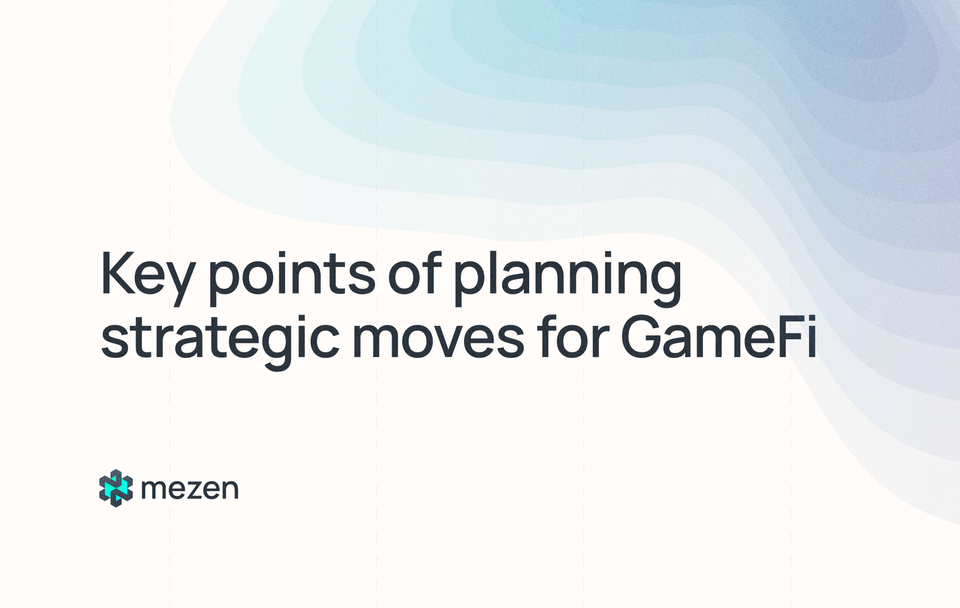Key points of planning strategic moves for GameFi

Speaking about the Web3 world, one cannot forget to mention the GameFi industry, which is growing at an incredible pace every year. In 2023, the revenue of the gaming industry amounted to USD 12.7B, with a Compound Annual Growth Rate (CAGR) of 28.50% from 2023 to 2032. The most enticing aspect of GameFi is the ability for players to earn a real-world income. Everyday players can monetize their time and skills spent in the game, opening up ways for people to earn a living wage just from gaming.
In the crypto industry, GameFi market projects occupy the majority, numbering over 3,000 projects. Since the emergence of GameFi five years ago, approximately 75.5% of the 2,817 projects in this direction have failed. Following the success of CryptoKitties in late 2017, P2E games have become popular in the crypto community, resulting in 422 Web3 games launched already in 2018, with 307 of them crashing.

Therefore, projects planning to enter this market with their products should carefully and thoroughly plan their strategic moves. Here are a few key points to consider:
- Competitiveness
With such a large number of projects in this niche, it is already challenging to come up with something truly new and interesting for the audience. Therefore, having competitors is not necessarily a bad thing; it can give you an advantage in creation. When creating a project, it is essential to pay close attention to competitors: analyzing their mistakes, successful solutions, and interesting features that have attracted users. This will give you an advantage and a solid foundation for entering the market, as you will already have a good understanding of the risks and opportunities. - Target audience
Every project has a specific target audience to which it aims during its creation: a specific nation or country, age group, interests, etc. There is nothing wrong with the target audience changing as the project evolves. However, trying to cover the entire market can be a big mistake, as the project may lose focus on the specific needs of its audience and, as a result, may lose it. Identify your key users, their needs, reasons for playing, and interests, and reflect this in your project to not only attract users but also maintain long-term relationships with them. The current big trend is attracting audiences from Web2 to Web3 through games because the gamer audience in Web2 is much larger. Therefore, projects should consider focusing on this user stream and launch a marketing campaign towards Web2, for example, combining Web2 and Web3 functionality in the game for gradual user engagement. - Strategy
It is crucial to develop a strategy for long-term development because companies often face the problem of reaching a peak and then losing direction on how to further develop, leading to stagnation and decline. For strategy, it is important to understand three key things:
— Company positioning, how you present yourself to investors and users.
— Goals, company development goals, preferably set measurable goals such as the number of users or revenue.
— Mission, what your game gives to society, what needs it meets, and what value it provides to users.
Based on these three things, you can understand the direction of development and outline strategic decisions to achieve goals. For GameFi projects, the key metrics are DAU (daily active users) and MAU (monthly active users), so the strategy should be built around the final goals based on these metrics. - Token utility
Many underestimate the importance of utility tokens for GameFi projects; however, utility tokens play a crucial role in the successful development of a project. It’s very important that the utility tokens not only be relevant within the project framework but also do not limit the opportunities of players who do not use them. Key utilities should naturally be features related to the game itself, allowing to expand its functionality. For example, the main utilities could include the ability to purchase in-game assets and items at a discount or purchase exclusive items, the ability to open loot boxes for tokens, or access to additional game chapters. - Expand the game offerings
A GameFi project should constantly work on developing and launching new games to attract a larger audience. By offering a variety of games, they can cater to different preferences and attract more players. - Invest in marketing and advertising
To grow bigger, project needs to invest in marketing and advertising to increase brand awareness and attract more players. This can include online advertising, influencer partnerships, social media campaigns, and other promotional efforts. - Focus on user acquisition and retention
It is important for a GameFi company to focus on acquiring new users and retaining existing ones. This involves improving the user experience, adding new features, and implementing strategies to keep players engaged and coming back for more. - Develop strategic partnerships
Collaborating with other companies, influencers, or brands can help a project reach a larger audience and grow faster. By forming strategic partnerships, they can tap into new markets, gain access to new players, and increase their visibility in the industry. - Offer rewards and incentives
Providing incentives, rewards, and special offers can help a project attract and retain players. By offering in-game bonuses, discounts, and exclusive perks, they can incentivize players to spend more time and money on their games, leading to growth and success. For instance, GameFi projects can offer limited rewards for a period of time or make a leaderboard with special prizes for top-10 players. - Community engagement
Building a strong community of users is essential for the long-term success of a GameFi project. The project should engage with its users through social media, forums, and other channels to keep them informed, involved, and excited about the platform. Blockchain games with the most active communities undoubtedly have a significant competitive advantage, as an incentivized community is going to provide extensive (and free) word-of-mouth marketing, giving projects further traction.


Comments ()